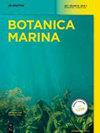Vertical distribution of brown and red macroalgae along the central Western Antarctic Peninsula
IF 1.4
4区 生物学
Q2 MARINE & FRESHWATER BIOLOGY
引用次数: 0
Abstract
Fleshy macroalgae dominate the hard bottom, shallow waters along the Western Antarctic Peninsula (WAP). Although there are numerous reports on their ecology, geographic distribution, and to a lesser extent, vertical (depth) distribution in the northern portions of the WAP, much less is known farther south along the central portion of the WAP. Here we provide the first report of the vertical distributions of brown and red fleshy macroalgae in this region based on scuba-derived collections at 14 study sites between southern Anvers Island (64.8°S, 64.4°W) in the north and central Marguerite Bay (68.7°S, 67.5°W) in the south. Although several overstory brown macroalgal species that can be common along the northern WAP including南极半岛中西部褐藻和红藻的垂直分布
在南极半岛西部(WAP)的硬底浅水中,肉质大型藻类占主导地位。尽管有许多关于它们的生态、地理分布的报道,以及在较小程度上关于WAP北部垂直(深度)分布的报道,但沿着WAP中部向南的报道要少得多。本文首次利用北部安弗斯岛南部(64.8°S, 64.4°W)和南部玛格丽特湾中部(68.7°S, 67.5°W)之间的14个研究点的水肺标本,对该地区棕色和红色肉质大型藻类的垂直分布进行了研究。尽管沿WAP北部常见的几种褐藻(包括Desmarestia anceps和Cystosphaera jacquinotii)在WAP中部几乎没有,但menziesii和Himantothallus tifolius褐藻的垂直分布与WAP北部相似,尽管它们的覆盖百分比要低得多。同样,14种分布最广的红色大藻的垂直分布反映了WAP北部的情况,尽管由于海冰浓度增加,该地区南部的大藻覆盖面积、生物量和总物种丰富度显著下降。
本文章由计算机程序翻译,如有差异,请以英文原文为准。
求助全文
约1分钟内获得全文
求助全文
来源期刊

Botanica Marina
生物-海洋与淡水生物学
CiteScore
4.10
自引率
4.50%
发文量
43
期刊介绍:
Botanica Marina publishes high-quality contributions from all of the disciplines of marine botany at all levels of biological organisation from subcellular to ecosystem: chemistry and applications, genomics, physiology and ecology, phylogeny and biogeography. Research involving global or interdisciplinary interest is especially welcome. Applied science papers are appreciated, particularly when they illustrate the application of emerging conceptual issues or promote developing technologies. The journal invites state-of-the art reviews dealing with recent developments in marine botany.
 求助内容:
求助内容: 应助结果提醒方式:
应助结果提醒方式:


